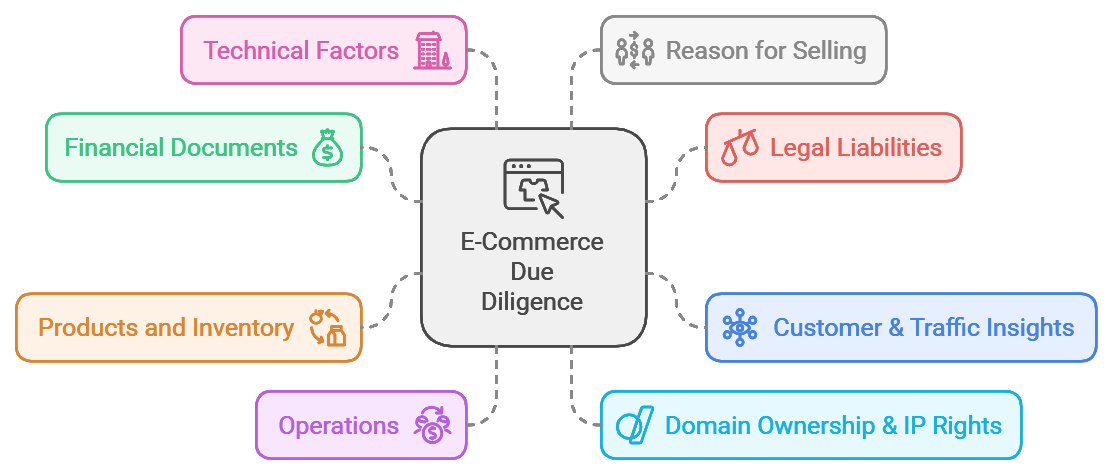Whenever someone asks me about how they can start their own online business to make money, most of them have e-commerce in their mind. Budding entrepreneurs think it’s easy to start their store, but I’ve learned that’s not the case. Real success needs some hard work but it’s better if you do it Smartly. That’s why I’ve put together this e-commerce due diligence checklist.
8 Key Factors For E-Commerce Due Diligence Checklist
Whether you’re new to the game or already running your shop, this can be a good guide to see if you are on the right path or not. The B2C E-commerce market is expected to reach $9 Trillion by 2032, so there are a lot more opportunities in this space than you think.

Here are the 8 key factors that you must look for when doing due diligence on any e-commerce business:
1) Check the Financial Documents
When it comes to e-commerce due diligence, finance is the most important thing as your main goal is to earn money out of it. I will always recommend diving into the financials to get a clear understanding of the business’s revenue, expenses, and profits. For that, you must evaluate and verify the Profit & Loss statements and Balance Sheet of the business for the past 3 years.
Getting this information helps me know exactly what I’m stepping into and whether the business is financially sound.
Taxes and Liabilities are also important factors to consider when doing your due diligence so you can grasp debts, loans, and other liabilities that could stop growth.
2) Look for Legal Liabilities
This is what some people miss out on, so I put it 2nd on this checklist. Legal due diligence is equally as important because you want to ensure your business or online store is playing by the legal rules. This means reviewing all the details regarding the products, where the product is made, and where it will be sold. This also includes ensuring you have all the licenses and permits to ensure everything is in place.
3) Know Your Customer & Traffic
Traffic means how many customers are coming to the e-commerce where and the details about these customers. It is the lifeblood of any e-commerce store. Analyze how customers are coming to the store, whether through social media, SEO, paid marketing, e-mails, etc. Also, see where are most of the customers are coming from and what their age, gender, and other demographic details.
You can find this traffic data from Google Analytics and the store’s analytics dashboard. Do the analysis on a weekly to monthly basis to see whether the business is growing or not. Sites like Ahrefs and SimilarWeb can also provide you with more information about the site.
It’s always better if there is more than one source of traffic. I would also advise you to review the traffic strategies of competitors and other successful brands in that niche. This helps me find ideas I can tap into for my own new business.
Moving more into the traffic analysis, it is an important step during any e-commerce due diligence to know more about the customers. You need to know the kind of customers that a current e-commerce store has, as well as the kind you are looking to attract. Learn more about their purchasing habits, average order values, and why they are choosing to buy from this store. This provides insights into whether they are loyal, high-value customers or not.
Equally important is assessing whether the current customer base matches your long-term business goals. You might want to target a different demographic or geographic area, in which case you’ll need to strategize how to transition or expand the customer base. Moreover, consider the customers you may want to avoid those who generate high return rates or have low retention potential. These insights can significantly influence your decision-making and help you avoid costly mistakes in the future.
4) Verify Products and Inventory
When I’m doing due diligence, verify all the information on products and investories is very important. I always start by assessing the current state of inventory. I check which products are moving quickly and which ones might need to be phased out if customers aren’t showing interest. I look for signs that inventory is well-managed with good systems and processes in place.
How inventory and supplier management works depends on the size and type of e-commerce business. For instance, if it’s a dropshipping business, it’s pretty hands-off since you don’t handle stocking. However if the business uses a wholesale or outsourced fulfillment model, understanding these areas becomes critical.
With a wholesale model, I dig deeper into the day-to-day operations, making sure to understand how things run and how long tasks take. I also check to see how automated and standardized the processes are to ensure the business runs efficiently and can scale smoothly.
5) Operations Evaluation
Digging deep into the operations is something new entrepreneur buyers tend to overlook, But you need to understand how much time is required to run the business and what is going to be your responsibilities. This helps me get a clear picture of what I’d be taking on and ensures that the business is fairly valued.
The best way for me to get this insight is by conducting a ‘task audit.’ This involves looking at all the tasks the owner and employees handle daily. For an e-commerce business, the key areas to focus on include managing inventory and suppliers, marketing, and customer support.
6) Verify Domain Ownership & IP Rights
Verifying domain ownership is one thing I always recommend you do because it is like buying a home that you don’t own the land. So one thing you need to do is to confirm who owns the domain. This step is often overlooked but is essential. Without full ownership of the domain, you wouldn’t have control over one of the business’s most valuable assets.
To verify domain ownership, what I do is to make sure the seller provides access to the domain registrar account. This can confirm that they truly own the domain and can transfer it to me once the deal goes through.
Also, when doing the e-commerce due diligence, review any legal and intellectual property (IP) issues. This means digging into the business’s legal standing and making sure all its IP trademarks, patents, and proprietary code are properly registered. By doing this, I can avoid potential legal headaches down the road, like lawsuits over incorrect or incomplete registration.
There can be many more digital and intellectual assets like email accounts, product designs, logos, and brand names that should be securely registered to prevent future legal problems. Protecting these assets ensures that the business has the full rights to use them without any issues popping up late.
7) Evaluate Technical Factors
Technical factors include all the technical details about the websites and other software that the e-commerce business is using. It’s easy to get caught up in other areas and overlook this, but the tech side is what keeps everything running smoothly.
Find out about the website platform (like Shopify, Woocomerce, Wix, etc), how reliable it is, and if it can handle expansion. Then, check for the website speed, the look (theme) of the website, the plugins/apps required to run the website properly, and how mobile-friendly it is since a lot of users shop online these days.
8) Reason For Selling
At last, you must ask the current owner of the business what they are selling. The answer might be to switch to something else or they want to retire, but sometimes, it can provide you with some deep insights. You might find some red flags that can be a problem for the future or some opportunities that grow it further.
Understanding their motivation for selling will help you assess whether the business is a good fit for you or not.
Whether you are buying an existing online store or just flipping the site for later, this checklist can help you a lot.
Get the best price for your business — we take care of the rest.
Start Selling for FreeE-commerce Due Diligence Checklist
Receive an instant valuation with our Ecommerce Business Valuation Tool.
Get My ValuationWhy Due Diligence Before Buying an E-Commerce Business is Important?
While you might have all the information you need about the business, proper verification of this information can help you eliminate any pitfalls in the future. Usually, buyers get so excited about the business and their new journey, that they tend to miss out on such key details. Sometimes, they even don’t know what to check. So, this checklist here will help them do the due diligence properly.
Our AI recommends the best listings based on your investment profile.
Discover MilesHow to Execute this Checklist?
While this list is exhaustive, you must never skip any of the steps to save time. You can perform the due diligence in the same order we mentioned, starting with a financial analysis to understand why the owner is selling his business. You must complete one step completely before moving to another step to not get confused.
You know that Prevention is better than cure and once the business is transferred to you, it will be your headache to deal with anything that comes up in the future.
We understand that it is difficult for new buyers to get all of these rights, and this is why Ecomswap has come in. All the online businesses listed on Ecomswap are vetted by us. While we ask the buyers to do this due diligence themselves, we also offer to help them in the process. We can explain to you all the finance, traffic, legal, and customer data before you make a decision.
Takeaways
Proper e-commerce due diligence ensures that you’re not just buying a website but a thriving online business. So, take some time and do this hard work once and for all. If you are looking for a checklist on any other type of online business, we have one on website due diligence in general also.





